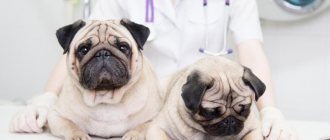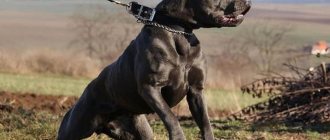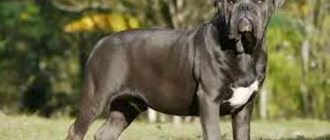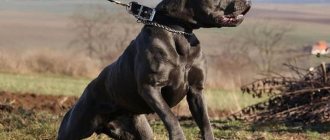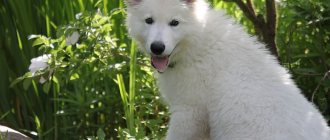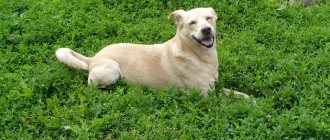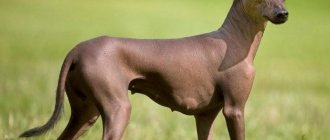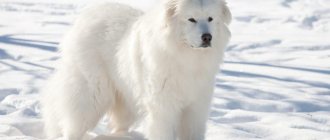Pets with flat faces are very popular among dog breeders. As a result of careful selection, the shape of the skull of representatives of the breeds was modified. Each dog had to fulfill its own role, in which scent was not of primary importance. This entailed a number of consequences that future owners should prepare for.
Peculiarities
Animals with this feature are called brachycephals. As a result of changes in the structure of the skull, the nostrils became narrow, and the palate, trachea and tear ducts became compressed. Physiological changes affected mainly the respiratory tract, so their health also became weaker. Dogs are sensitive to high temperature, stress, pain, and physical exertion. Any violation invariably leads to increased breathing.
The structural features of the larynx and trachea can lead to the development of oxygen deficiency and fainting. If your dog frequently loses consciousness, you should contact a veterinarian. Otherwise, an innocent symptom can lead to heart failure. However, the main health feature of flat-faced dogs is brachycephalic syndrome. This means that when hot air is inhaled, it does not have time to cool before entering the lungs and can lead to heat stroke.
Dogs with flattened faces scare novice dog owners with reverse sneezing. The pet often sucks in air, sniffles, wheezes and grunts. At the same time he freezes in a tense position. The cause of the phenomenon is dust or pollen, which irritates the mucous membrane in the nasal passage. Sometimes reverse sneezing is caused by an inflammatory process inside the body that develops after an infection.
The phenomenon itself does not pose a danger to life and health. This usually happens rarely, does not last long and goes away on its own. If you want to help your pet, then just cover the nostrils with your fingers so that the dog inhales through his mouth.
If attacks are repeated frequently or cause significant harm to the animal, then you should consult a specialist. Veterinarians advise filming reverse sneezing.
Nutrition
Lancashire Heelers are unpretentious eaters. The diet of an adult dog can consist of natural products, where the basis is boiled meat. One fifth of the menu can be made up of cereals, boiled vegetables, and sour-milk products. You can choose premium or holistic food (natural based). In both cases, include fresh vegetables and fruits in your diet.
At first, it is recommended to give puppies cottage cheese, other fermented milk products, cereals, eggs, then you can switch mainly to a protein diet (meat). Or also choose a good ready-made food for active puppies. Having clean and sufficient drinking water is essential for Lancashire residents.
Varieties
Cute faces with a flattened nose evoke a lot of warm feelings in people. Let's look at which animals have this appearance - a complete list of breeds.
- Pug. Once upon a time, this dog was supposed to keep people warm. This explains the large number of fat folds. The nose did not play a special role in this case, so the selectors decided to deepen it. There is an opinion that pugs were loved by women as decorative dogs and were supposed to contrast with the appearance of the mistress. Smooth-haired representatives of the breed often develop brachycephalic syndrome; they snore quite loudly in their sleep and grunt when they increase physical activity.
- Bulldog French and English. It’s hard to imagine, but the breed was bred to participate in bull-baiting – fighting with bulls. Over time, the fun changed, and bulldogs began to participate in dog fights. The nose was always in danger during such activities, so the selectors carefully hid it. Moreover, the representatives of the breed themselves often ended fights by biting the enemy on the nose, as the weakest point.
- Pekingese. In China, such a dog was an indicator of the status of the owner. There, animals of this breed were bred in packs, and they were supposed to protect people. The nose was hidden to protect the pet. With such activities, the selectors paid more attention to the development of a powerful jaw and sharp teeth. Today, the small fluffy breed is used as a decorative one.
- Shar Pei. People from the southern province of China performed different tasks. Representatives of the breed were fighters and hunters, at the same time taking care of the herd and taking care of children. During selection, the nose was shortened and great emphasis was placed on the development of the jaw. A pinched nose allows the dog to tightly squeeze its prey in its jaws for a long time. This anatomical feature allows the animal to guard the victim for the required amount of time until the owner approaches. Particular attention should be paid to the dog’s breathing; under stress, it becomes much faster.
- Boxer. The dogs were bred by enthusiasts who dreamed of creating the perfect watchdog. There is an opinion that the name of the breed is due to the fact that in defense the animals actively use their forelimbs. The nose was deepened to increase the dog's safety during fights and external aggression.
- Dogue de Bordeaux. The large animal has excellent protective qualities and is able to stand up for both itself and its owner. The dog protects people, not territory, so it can live in an apartment.
Bull Terrier – Gladiator in a White Tailcoat
England is considered the birthplace of all rat-faced dogs. This breed was developed by James Hincks. Back in the 19th century, he introduced everyone to a white dog with an ordinary appearance. After some time, a fighting bull terrier of a different color appeared. Several completely different breeds took part in the selection:
- English bulldog;
- Dalmatian;
- white English terrier.
Bull Terrier dog
For many years it was believed that keeping a house of this breed was a sign of good taste. The rat-like dog was a huge success among almost all dog breeders in England. The breed standards are as follows:
- muscular torso;
- height up to 55 cm;
- weight up to 30 kg;
- long elongated head with a shark mouth;
- powerful jaws;
- small tail;
- a big nose.
The color can be varied, but most attention is paid to white wool. A dog with a muzzle like a rat, despite its muscular build, has sufficient agility and can jump high
Bull Terrier resting
Head structure
Almost immediately, a dog with a rat's face catches the eye due to the unusual egg-shaped head. Many people find her attractive. The features are as follows:
- the muzzle immediately catches the eye due to the powerful jaw, the teeth are very strong;
- the head is set low on a muscular and strong neck;
- The ears are triangular and erect. They are located quite close to each other;
- the nose is large. Many people argue that a dog with a long nose resembles a rat and is therefore unattractive;
- The eyes are very small and set wide apart, which is why many people think that the dog looks like a pig.
Note! A pit bull with a sharp muzzle is not an elegant dog. The dog's habits look unusual due to its massive body and interesting face.
Bull Terrier head
Coat and colors
Pit bull terriers or pit bulls must be white in color according to the standards. Skin pigmentation largely determines a dog's attractiveness. In addition, wool can be of other shades:
- red color without any markings. In this case, shades can differ significantly, even dark brown;
- black color is less common than others;
- Two-color bull terriers differ from others in that they have large areas of contrasting color. There are a variety of combinations, for example, black and red. White patches spread over the face, paws or chest. Ideally, they should account for no more than 50% of the color;
- There is also a three-color color variant. It is represented by a combination of black, red and white. In most cases, a black tint predominates; white should be no more than 50%. The red color accounts for the least, it appears on the muzzle or chest, as well as on the limbs.
- brindles were not immediately recognized, but eventually they began to be considered at exhibitions. The color of such a dog is represented by a combination of red and dark stripes. In some cases there are white markings.
The coat is thick and short, so a dog with a large nose is also suitable for keeping in an apartment. The pet does not require careful care.
Important! Almost all dog breeders claim that blue color is absolutely unacceptable and such individuals should not be bred.
Keeping puppies
All breeds with flattened muzzles were bred artificially; targeted selection reinforced the desired trait. The result was a modified shape of the skull, which entailed both positive and negative results. All breeds suffer from specific health problems and therefore require special care. The structural features of the respiratory tract make it difficult to inhale and exhale. Representatives of the breed may feel worse as a result of a congenital mutation that is not provided for by the standard.
Dogs can suffer from heart failure due to increased pulmonary artery pressure. It is important that one minor problem can lead to quite life-threatening diseases. The characteristics of the breeds must be treated carefully. Protect your dog from extreme heat, exercise, and stress.
If the heart rate increases, you should immediately calm the animal. In this condition, the body requires more oxygen. Air flows in only in limited quantities due to the narrow airways. As a result of prolonged stress, the animal may lose consciousness. If the animal is still small (up to 1.5 years), then it is worth protecting it from any stressful situations.
It is worth monitoring the weight of a dog with a flattened muzzle. If an animal is obese, it gets tired faster and feels worse in the heat. All this negatively affects breathing. Puppies should be fed on a schedule and in doses recommended for the dog's age. This rule is especially important for pugs, who have a very good appetite and do not like active games.
Choose the right collar so that it does not squeeze your throat. It is generally recommended to use a harness for walking. Do not make sudden jerks with the leash, which could result in choking, loss of consciousness, or even death. During hot summers, it is worth reducing the number of walks. Take your dog outside only early in the morning and in the evening when the air temperature drops.
Most brachycephalic breeds have folds near the nose. They themselves are not harmful, but require careful care. Regularly and carefully clean your skin of debris and food debris. For severe contamination, use a cotton swab with hydrogen peroxide and then wipe dry.
Special rules for keeping flat-faced dogs include a number of nuances.
- It is necessary to visit the veterinarian annually for consultation. The examination should include not only external diagnostics, but also an ultrasound of the heart, x-rays, examination of the larynx, and listening to the condition of the lungs and heart. Such measures will help detect diseases or pathologies in the early stages.
- It is worth contacting a specialist if the animal makes uncharacteristic sounds or has changed significantly in its habits.
- Regularly inspect the condition of the ears, eyes, folds near the nose and the respiratory canals themselves.
Brachycephalics cannot fly on an airplane - it is contraindicated for them. Changes in pressure, heat, stress can lead to the death of a pet. Moreover, it is quite hot on board an airplane, which also leads to heat stroke. If you are planning a trip, make sure you have someone at home to look after your dog.
A change in your usual environment and the absence of your beloved owners can also negatively affect your health.
Watch the video below for veterinarians' opinions on dogs with flat faces.
Dog breeds with a flat muzzle are called brachycephalic in veterinary medicine. In such animals, the skull is modified as a result of artificial selection. Their muzzle is short and flat, which makes dogs susceptible to certain physiological problems related to breathing.
History of the breed
As is often the case with ancient breeds, it is difficult to determine their exact origins. One thing is certain - Lancashires appeared in England. Once upon a time, more than 200 years ago, a breed of Welsh Corgi was used to herd domestic animals from Wales to the northern and western parts of England.
In the Ormskirk area, whether by accident or design, one of the Welsh Corgis crossed with a black and brown Manchester Terrier. This is presumably how the Lancashire Heeler breed . By the way, in her homeland she is also called Ormskirk heeler or Ormskirk terrier.
In its area, this dog has become quite popular among livestock owners. She did an excellent job as a driver and shepherd. Gradually, the breed died out, until in 1960, dog enthusiast Gwen McIntosh began actively restoring the dog.
In 1978, she and other breeders formed the Lancashire Heeler Club and became its president. They developed an initial breed standard and registered. Recognition by the English Kennel Club followed in 1981. Gwen McIntosh continued to serve as president until her death in 1992.
In 2006, the breed was recognized as vulnerable local. This meant that annual registration numbers did not exceed 300. In 2016, the Fédération Cynologique Internationale added the breed to its list of provisionally accepted breeds.
List of brachycephalics
Dogs referred to by this term include:
- bulldogs (French and English) - originally bred as fighting dogs;
- pugs - created to warm a person;
- Pekingese;
- Dogues de Bordeaux;
- bullmastiffs;
- Boxers are also fighting dogs;
- Shar-Pei;
- Japanese Chin;
- chihuahua;
- Pomeranian Spitz, etc.
These breeds were specially bred through selection work aimed at obtaining and consolidating the desired trait - a short, flattened muzzle. But, unfortunately, the dogs received many additional health problems.
The respiratory tract in dogs with a flat face has undergone changes: the nostrils have narrowed, the soft palate has enlarged, defects in the formation of cartilage tissue and the trachea are common, the lacrimal canaliculi are meek or folded. All pets of these breeds are forced to make efforts during the breathing process in order to take a normal breath.
Brachycephalic syndrome
This is the name for narrowing of the airways, which is of clinical significance. In the dog’s body, the nostrils, nasal passages are narrowed, the soft palate, on the contrary, is elongated, the larynx and trachea are deformed. The result is severe shortness of breath and wheezing. Symptoms worsen in hot weather, stress, and physical activity. The condition can lead to a severe lack of oxygen and even cause the animal to faint.
In dogs of brachycephalic breeds, due to respiratory failure, pulmonary pressure is often increased and cardiac pathologies occur. Pulmonary edema and airway obstruction are often diagnosed in these animals and often lead to sudden death, the cause of which is suffocation.
Is there a way out? Some veterinarians resort to plastic surgery, after which the dog’s condition improves.
Price
At the moment, the Lancashire Heeler in Russia is a very rare dog. We do not have nurseries that purposefully breed this animal. Therefore, the bulk of purebred Lancoshires come to us from abroad - Finland, England and Holland. The price of a Lancashire Heeler abroad ranges around $400-450. Considering transportation, it will be more expensive.
It is possible that buying a puppy from our country could cost you about $1,000. When purchasing a purebred Lancashire, you must ask for documents about the purity of the breed, about all vaccinations carried out, in order to exclude getting an unhealthy puppy or a fake. You can find several groups on social networks where there are options for purchasing or selling puppies of this breed.
What should you pay attention to?
The owner of a dog with a flat face should be aware of:
- How a dog breathes in the heat. Respiratory failure combined with overheating is a dangerous sign that can lead to irreparable consequences and even death.
- Do the animal's nostrils stick together when inhaling?
- Does the dog make sounds or groans when breathing?
- If your pet constantly snorts, sneezes, puffs, this is abnormal.
- While wearing a collar, the dog begins to cough. There is no point in causing suffering to your pet once again, but it is better to walk your dog on a harness.
- It is worth monitoring the animal’s weight and not allowing it to gain extra pounds.
Alaskan Malamute
The Alaskan Malamute was bred by the Eskimo tribe for sledding. The height of males reaches 63.5 cm and weighs 38 kg. The dogs have a strong build. Appearance is distinguished by the presence of a “mask” on the muzzle or a “hat” on the head. The hair is dense, medium length, thick, rough. There is undercoat
In summer, the coat becomes slightly lighter and shorter. Pay attention to the color of your pet:
- Variations from a light shade of gray to black are acceptable. There are shades of red and sable.
- The combination of shades on the pants, undercoat, and markings is not considered a disadvantage.
- A solid color can be exclusively white.
- Uneven or interrupted color is undesirable.
- Markings often become a distinctive feature.
Signs that require urgent veterinary attention
If the dog has a flat face, the owner should be constantly alert. Here are signs that require urgent attention to a veterinarian:
- loud wheezing when breathing;
- unnatural posture of the animal;
- rapid breathing;
- animal anxiety;
- pale or blue tongue, lips and gums;
- foam coming out of the mouth.
In all these cases, you should not give the dog water or medicine; you should provide air flow and urgently take the animal to the doctor.
Reproduction and lifespan
Breeding these dogs is best left to professionals, because the important factor of paperwork, as well as the nuances and difficulties of obtaining a purebred breed, can be difficult for a beginner. Therefore, trust experienced breeders and buy yourself a purebred puppy from trusted nurseries.
From the first days a puppy appears in the house, the owner is obliged to take care of its upbringing and socialization. The optimal age for this is 2-3 months. It is important to show your pet the world around him, other animals, including cats. It is necessary to train the puppy not to “herd” people - not to grab ankles, even when playing.
Lancashire Heeler puppies need a dominant trainer because they are stubborn and intractable from childhood. It is through training and education that these qualities will be overcome. Just don’t use rudeness or violence against them.
Average life expectancy is 12-15 years. Diseases: Collie eye anomaly, dislocation of the primary lens (eye lens), persistent pupillary membranes. May suffer from a dislocated kneecap.
Other possible health problems
In addition to respiratory pathologies, dogs with a flat face also have other pathologies:
- Disturbances in the outflow of tear fluid. It happens that the eyes of such dogs constantly get wet. It may also be the other way around - the eyeball is not sufficiently moistened, especially if the organs of vision are enlarged.
- Dental diseases. Brachycephalics often have an incorrect bite, which is why plaque, tartar, and gingivitis appear.
- Excessive wrinkles on the face lead to the spread of fungal infection.
- Thermoregulation problems. Brachycephalics often suffer from excessive body temperature.
- Allergic reactions are by no means uncommon in dogs of the breeds in question. They manifest themselves in the form of skin rashes, as well as respiratory spasms.
- Tendency to gain excess weight. Dogs of brachycephalic breeds should not be overfed; excess weight can significantly worsen their health.
Shar Pei
A dog distinguished from other breeds by a large number of skin folds. Shar Peis have a sense of self-esteem and do not bother the owner with the need for careful grooming. The only thing that the owner should take into account is the dog’s need for long and frequent walks to maintain its muscle corset.
The pet is squeamish about water, and therefore it is not worth bathing it often.
The characteristics of the breed are:
- Balanced character.
- Loyalty to the owner.
- Security qualities.
- Cleanliness.
Dog experts call willfulness of character, aggression towards other animals, and health problems in the form of allergic reactions as disadvantages.
Reverse sneezing
This phenomenon is often observed in brachycephalic dogs. It looks like this. The dog spreads its front legs, tenses, and makes a series of snorting sounds for a minute. After the attack he behaves as usual. It could also be different: the dog inhales, makes a loud sound and freezes, stretching his neck.
Such sneezing can be caused by strong odors, emotional reactions, and dust getting into the nose. It is not a pathology, and its features are caused by the specific structure of the muzzle. But such a phenomenon should be distinguished from brachycephalic syndrome, and therefore it makes sense to film the attack and show it to the veterinarian. As a rule, no additional measures are required during an attack; the sneezing goes away on its own.
Pomeranian coat colors
When choosing a puppy, great attention is paid to its color. It is difficult to understand from a “children’s” coat what it will be like on an adult dog.
There are several color options:
- red of different shades with lighter tail and ears;
- orange is a spectacular variety of red;
- cream - from bright, warm to delicate, cold tones;
- sable - with red, cream or beige undercoat;
- zonal gray – black wool with light undercoat;
- black – pure color or with sparse light hairs;
- black and tan – throat, chest, paws, muzzle fawn or red, main color – black;
- paticolor - spots of different colors on a white background;
- black and white - the main color is white, and there are black markings of various shapes on it;
- brown – rich, even chocolate-colored color;
- black-backed - consists of two colors, the darker one is located on the back, upper part of the tail, head and hips;
- white – snow-white, without hints of spots or shades;
- gray is a rare color in which ash is combined with black;
- blue – gray with a hint of steel.
Air travel ban
Owners of the dogs in question may be faced with the fact that their pet will not be taken on board the plane, and will also not be allowed into a special compartment for transporting animals. This is due to the frequent death of such animals during flight. Stress and changes in pressure trigger the mechanism of acute respiratory failure in a dog. Therefore, you should not be upset because of the ban, but it is better not to risk the life of the animal and leave it with relatives or friends for a couple of weeks. This way you can save the dog's life.
Let's take a closer look at some brachycephalic dog breeds and their characteristics.
Infection with worms
This can happen if a person gives their four-legged friend too much raw fish or meat. When such food predominates in a dog’s diet, there is a high risk of infection with worms. As a result, the dog is thin, and the owner believes that there is no reason for this
That's why you need to pay attention to your pet's nutrition. The presence of worms in a dog is a serious sign
The owner needs to urgently take action before the situation begins to get out of control. Regarding helminths, it should be said that all pets (even thin ones) should be given anthelmintic tablets once every three months for prevention purposes.
Pekingese
A breed considered sacred in Ancient China. It is suitable for an inexperienced breeder, but families with small children should not take the dog, as the child can injure the animal.
Pekingese puppies are almost impossible to train due to their stubborn nature. The dog barks often, and for no apparent reason. This feature is also worth considering, especially if you decide to get a Pekingese puppy in an ordinary city apartment.
The advantages of the breed are longevity and cleanliness. Difficulties include caring for the coat and difficulty getting along with family members and other animals.
Terriers
The undisputed leaders among terriers are the following breeds:
- West Highland white (30 cm/10 kg). Strong little white dogs. The fur is of medium length. It is presented in two layers - a hard cover and a soft bottom layer. It creates a feeling of fur. The pet's coal-black nose looks contrasting.
- Yorkshire (up to 3.1 kg). A small breed with unfixed growth parameters at the withers. Long-haired type with hairs falling straight and evenly down. There is no undercoat. The hairs are compared to human hairs. The standard color is dark bluish-steel. Deviations are acceptable - yellow-brown and shades.
Pugs
This small, flat-faced dog is a sweet, low-maintenance pet. The pet spends most of its time sleeping. The dog is sociable, playful, loyal to its owner, but sometimes stubborn. You can have a pug in the family. where there are small children. The dog is loyal to children's pranks, sometimes turning into a cute soft toy.
Caring for a pet is easy. It is important to wipe the fur daily; the pug’s eyes are treated with a cotton swab dipped in tea leaves. The nasal folds are treated with cotton pads soaked in alcohol-free baby lotion. You can bathe your dog 1-2 times a month.
Interesting Facts
- Despite the fact that it is generally accepted that the origin of the breed dates back to the late 18th and early 19th centuries, very similar dogs were depicted in ancient paintings found in Wales and having a more ancient history. Short-legged black-brown dogs, very reminiscent of the Lancashire terrier, were carefully depicted in a scene from the village life of ancient Welsh shepherds. This leads to the idea that the breed is much older than is commonly believed.
- Lancashire Heelers are commonly called “smiling” dogs. Indeed, their inherent friendly “smile” has already become a proverb, which is why the dog is often used in homes for the disabled and the elderly. They help brighten the lives of sick people.
- Under no circumstances should you purchase a pet from a poultry market. This is such a rare breed that ordinary sellers will not even undertake to sell purebred puppies. You will almost certainly buy a fake.
- Almost all pedigree dogs have two names - official according to documents and home. The first is used in the exhibition career, is included in diplomas, and the home one is used in the family; it remains with the pet for life.
French Bulldog
This breed is a smaller version of the English Bulldog. The dog is muscular, initially it was bred to participate in battles, but later it was classified as an ornamental breed. By nature, the pet is cheerful and cheerful.
Features of the French Bulldog breed are:
- Calm disposition, lack of fear.
- They cannot stand loneliness and need constant communication with their owner.
- Requires minimal grooming (hair brushing and infrequent washing).
- Stubbornness, due to which one should not expect success in training.
Terriers
Description of the Alaskan Malamute with photos and characteristics of the breed, varieties and features of keeping the dog
The undisputed leaders among terriers are the following breeds:
- West Highland white (30 cm/10 kg). Strong little white dogs. The fur is of medium length. It is presented in two layers - a hard cover and a soft bottom layer. It creates a feeling of fur. The pet's coal-black nose looks contrasting.
- Yorkshire (up to 3.1 kg). A small breed with unfixed growth parameters at the withers. Long-haired type with hairs falling straight and evenly down. There is no undercoat. The hairs are compared to human hairs. The standard color is dark bluish-steel. Deviations are acceptable - yellow-brown and shades.
Dogue de Bordeaux
This is a large animal with long hair. These dogs are also called French Mastiffs. The animal looks scary, but has a calm disposition. They have a well-developed intellect and excellent memory.
Breed Features:
- Excellent security qualities.
- I am ready to stand up for my own people to the death.
- It can show aggression towards “strangers”, but more often it frightens by barking. He can throw it only as a response.
- They get along well with other dogs, but are intolerant of other people's pets and can be aggressive.
The dog is intended to protect family members, and not the local area, so it can easily live in an apartment, but it is worth considering its rather large size.
Grooming includes combing the fur, trimming the claws, and regularly examining the eyes and ears. Frequent bathing is not required; the procedure can be replaced with dry cleaning.
Exotic Shorthair
In shortened form, this breed of cat with a flattened muzzle and large eyes is called exotic. She owes her appearance to the crossing of Persians with an American shorthair cat. In appearance, exotics are very reminiscent of extreme Persians, but unlike the latter, they have short, soft hair, which saves owners from the need to spend a lot of time on regular grooming. Among the characteristic features: strong short legs, an expanded chest and large size (the weight of some animals exceeds 8 kg). The color of representatives can be very diverse, from white and black to noble blue.
The cute plush appearance of the exotic cat fully matches its character. These pets differ from their Persian ancestors in a more affectionate, playful disposition, without unnecessary aggression, and therefore are considered an ideal option for families with children. They rarely speak, love their owner very much and get along without problems in the same territory with other animals.
